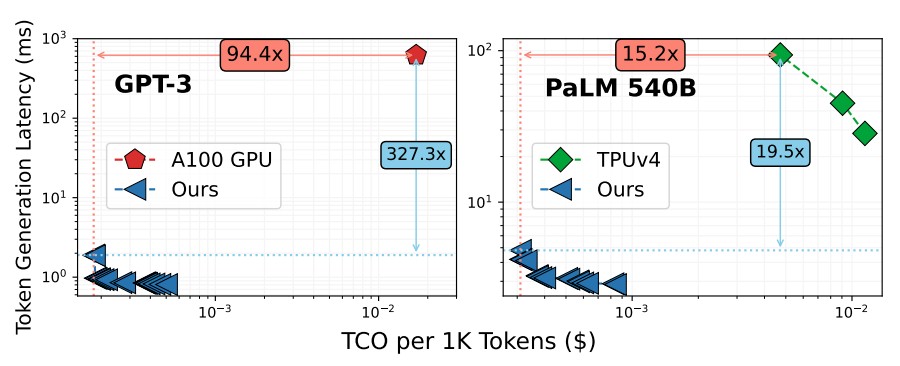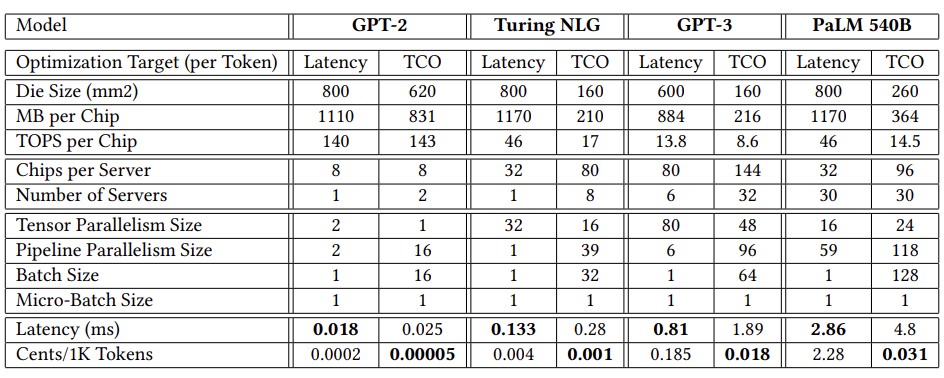Chiplet Cloud Can Bring The Cost Of LLMs Way Down

If Nvidia and AMD are licking their lips thinking about all of the GPUs they can sell to the hyperscalers and cloud builders to support their huge aspirations in generative AI – particularly when it comes to the OpenAI GPT large language model that is the centerpiece of all of the company’s future software and services – they had better think again.
We have been saying from the beginning of this generative AI explosion that if inference requires the same hardware to run as the training, then it cannot be productized. No one, not even the deep-pocketed hyperscalers and cloud builders, can afford this.
Which is why researchers at the University of Washington and the University of Sydney have cooked up a little something called the Chiplet Cloud, which in theory at least looks like it can beat the pants off an Nvidia “Ampere” A100 GPU (and to a lesser extent a “Hopper” H100 GPU) and a Google TPUv4 accelerator running OpenAI’s GPT-3 175B and Google’s PaLM 540B model when it comes to inference.
The Chiplet Cloud architecture was just divulged in a paper based on research spearheaded by professors Michael Taylor, of the University of Washington, and Shuaiwen Leon Song, of the University of Sydney who also happens to be a visiting professor at the University of Washington and has just joined Microsoft earlier this year.
Interestingly, Song was a senior staff scientist and technical lead at Pacific Northwest National Laboratory as well as a faculty member working on future system architectures at those two universities before joining Microsoft in January of this year as senior principle scientist to co-manage its Brainwave FPGA deep learning team and to run its DeepSpeed deep learning optimizations for the PyTorch framework, which are both part of Microsoft Research’s AI at Scale collection of projects. On the original paper, Song’s Microsoft email was listed and we assumed this was the affiliation for the Chiplet Cloud research, as is commonly done in papers. But this was in error, and Taylor and Song both sent us a note saying this research predates Song’s Microsoft jobs and has no affiliation with Microsoft.
That said, we think Microsoft had better look at what Taylor, Song, and their co-researchers are proposing. Because it is interesting.
(An aside: Not for nothing – and we really mean that as you will see – the projects that Song is taking over are among the projects that were bested by GPT, forcing Microsoft to shell out a $10 billion investment in OpenAI at about the same time Song was joining Microsoft. To date, Microsoft has given OpenAI $13 billion in investments, much of which will be spent to train and run GPT models on Microsoft’s Azure cloud.)
A Massive Array Of Matrix Math
If we had to summarize the Chiplet Cloud architecture in one sentence, which we kinda have to do, it would be this: Take a wafer-scale, massively parallel, SRAM-laden matrix math engine like the one designed by Cerebras Systems, hold it in the air perfectly level, and let it drop on the floor in front of you and then pick up the perfect little rectangles and stitch them all back together into a system. Or rather more precisely, instead of doing waferscale matrix math units with SRAM, make a whole lot of little ones that have a very low individual cost and a very high yield (which also pushes that cost down), and then stitch them back together using very fast interconnects.
The approach is akin to the difference between what IBM was doing with its BlueGene line of massively parallel systems, like the BlueGene/Q installed at Lawrence Livermore National Laboratory, and what it did with the GPU-heavy iron in the “Summit” supercomputer at Oak Ridge National Laboratory. BlueGene, very much like the “K” and “Fugaku” systems at RIKEN Lab in Japan, in the long run might have always been the right approach, only we would need different processors tuned for AI training and HPC calculations and for AI inference.
We have been talking about the enormous cost of building systems to run transformer-based generative AI models in recent weeks, and the Chiplet Cloud paper does a nice job of laying out why Amazon Web Services, Meta Platforms, and Google have been trying to find ways to make their own chips to make AI inference less expensive. Microsoft is no doubt thinking along the same lines.
“Serving generative transformer-based large language models on commodity hardware, like GPUs, is already hitting a scalability wall,” the researchers, who include Huwan Peng, Scott Davidson, and Richard Shi at the University of Washington, wrote. “State-of-the-art GPT-3 throughput on GPU is 18 tokens/sec per A100. ChatGPT and the promise of integrating large language models into various existing technologies (e.g. web-search) puts into question the scalability and profitability of large-language models. For example, Google Searching processes over 99,000 queries per second. If GPT-3 is embedded in every query, and assuming each query generates 500 tokens, Google needs 340,750 Nvidia DGX servers (2,726,000 A100 GPUs) to keep up. The cost of these GPUs exceeds $40 billion in capital expenditure alone. Energy consumption will also be huge. Assuming a 50 percent utilization, the average power would be over 1 Gigawatt, which is enough energy to power 750,000 homes.”
The problem with the GPU – any GPU, not just those created by Nvidia – is that they are general purpose devices and therefore they have to have a lot of different kinds of compute to satisfy all of their use cases. You know this is true because if it wasn’t, Nvidia GPUs would just have Tensor Core processors and not vector engines as well. And even with a device like Google’s TPU, which is essentially just a Tensor Core processor, the size and complexity of the device, with its HBM memory stacks, makes it very expensive to deliver even if it does, at least according to the comparisons in the paper, offer much better total cost of ownership (TCO) than an Nvidia A100 GPU. Like this:
Note: This Chiplet Cloud paper gets pricing for A100 capacity on the Lambda GPU Cloud and TPUv4 pricing comes from the Google Cloud, of course.
And here is the data underlying the chosen reference data points in the chart above, which is fascinating:
On the GPT-3 model with 175 billion parameters, the simulated Chiplet Cloud devices had a stunning 94.4X reduction in cost per 1,000 tokens processed for the inference and an absolutely amazing 327.3X reduction in token generation latency compared to Nvidia’s A100 GPU. Even if the throughput of the H100 is 3.2X higher than on the A100 (which is comparing INT8 throughput on the A100 to FP8 throughout on the H100), we have no reason to believe the latency will be that much different even with HBM3 memory that us 50 percent faster. And even if it was, the H100 costs about 2X on the street what an A100 costs right now. The H100 would be down and to the left of the A100 on the chart above, to be sure, but it has a very big gap to close.
The shift to a tensor core style matrix math engine with HBM memory helps to a certain extent, as the right side of the chart above featuring the TPUv4 compute engine shows, and even with a much larger PaLM model with 540 billion parameters. The theoretical Chiplet Cloud shows a 15.2X reduction in cost per 1,000 tokens generated running inference and a 19.5X reduction in latency.
In both cases, the Chiplet Cloud is optimizing for low cost per token and paying for it with a reasonable amount of latency. And clearly with the Chiplet Cloud architecture it can drive down latency a little bit lower if customers are willing to pay a proportionately larger higher cost for those inferrings.
We love this chart, which shows why the hyperscalers and cloud builders are thinking about custom ASICs for AI inference, particularly when LLMs need so much compute and memory bandwidth to do inference:
The denser the AI work, the better the cost improvement is for using an ASIC compare to using a GPU, and incidentally, this chart also suggests Google search is much more intensive than Bing search and lower cost, too. (Hmmmmm. . . . Don’t count Bard out just yet.) The breakeven point between the GPU and the custom ASIC is at around 46,000 tokens per second. This performance was based on Microsoft’s own DeepSpeed-Inference engine running on the Lambda GPU Cloud at a cost of $1.10 per hour per GPU against a DeepSpeed-Inference run on a simulated Chiplet Cloud accelerator.
In designing its Chiplet Cloud, the researchers came to a few conclusions.
First, the cost of producing the chip is a big part of the overall TCO of any computing engine.
By our estimates, GPUs represent 98 percent of the compute capacity and probably 75 percent of the cost of a modern HPC/AI supercomputer. They reckons that the cost of making an accelerator for LLM inference is around $35 million for a chip etched in a 7 nanometer process, which includes the cost of CAD tools, IP licensing, masks, BGA packaging, server designs, and human labor. Against a potential $40 billion investment, this is peanuts. This is peanut dust.
This means you can’t use reticle-busting compute engines if you want to drive down costs. The researchers said in the paper that for 7 nanometer processes from Taiwan Semiconductor Manufacturing Co, with a defect density of 0.1 per cm2, the unit price of a 750 mm2 chip is twice that of a 150 mm2 chip.
Second, inference is as much a memory bandwidth problem as it is a computational one.
To make the point, unfortunately using an older GPT-2 model and an equally older Nvidia “Volta” V100 GPU, most of the GPT-2 kernels had low operational intensity – meaning they didn’t need much flops after all – and were limited by the 900 GB/sec of HBM2 bandwidth. Moreover, the researchers calculated that it would take 85,000 GB/sec – nearly two orders of magnitude more bandwidth – to drive the entire 112 teraflops of computing oomph in the V100 GPU to run GPT-2 efficiently.
And given this, the secret to the Chiplet Cloud is exactly what Cerebras Systems, GraphCore, and SambaNova Systems already figured out: Get the model parameters and their key value intermediate processing results that are recycled to speed up generative models all into SRAM as close to the matrix math engines as possible. The gap is huge here between DRAM and HBM:
So SRAM seems to be a no brainer here.
The other thing is that there needs to be a way to mitigate package costs for chiplet designs as well as limiting inter-chip communication, which increases the inference latency and decreases throughput. So the researchers are proposing the use of a chiplet as a package and doing the integration at the board level, not the socket level, and is using tensor and pipeline parallelism mapping strategies to cut down on inter-node communication across the Chiplet Cloud boards. And each chiplet has enough SRAM to hold the model parameters and KV cache for all computational units. In effect, you have a massively distributed cache that is then chewed on by individual chiplets as they do their own unique inferences.
The proposed Chiplet Cloud looks like this:
And it has no silicon interposer or organic substrate integration that adds to cost and complexity and that lowers package-level yield, which is also an issue with these big, fat, wonderful devices like GPUs and TPUs. The chiplet board connects a bunch of chiplets in a 2D torus using printed circuits, which the researchers say is flexible enough to accommodate different mappings of the devices. (This is similar to what Meta Platforms was doing on the circuit boards for its GPU accelerator systems using PCI-Express switching as an interconnect.) The circuit board has an FPGA controller, and each chiplet has a full-duplex link running at 25 GB/sec with 80 mm reach using ground reference signaling. Other kinds of interconnects could link the nodes together as needed, they say.
They add that different models would require different chiplet compute and memory capacities for different models and for whether they are optimized for latency or TCO. Which is very interesting indeed:
The lesson here is that one size never fits all. You can have something that is more general purpose, but you always pay with lower efficiency. Cloud builders need general devices because they never know what people will run – unless they just intend to sell services against a proprietary software stack, in which case they can optimize like crazy and give the best price/performance and keep some of the leftover money – which only happens if they don’t over-optimize – as profits.
Wouldn’t it be funny if Chiplet Clouds were manufactured and sold to Google that were optimized to run PaLM 540B? Or stole TPU customers away from Google Cloud to Microsoft Azure if it manufactured a custom Chiplet Cloud geared to PaLM 540B? Stranger things have happened. And the idea is out there now, and it can be a bargaining chip against Nvidia and AMD. Some of you who have always wanted a startup might be able to use this idea to create a clone of what the researchers have suggested. Groq did that with the TPU, and AI venture capital seems to be still relatively freely available. Why not?









